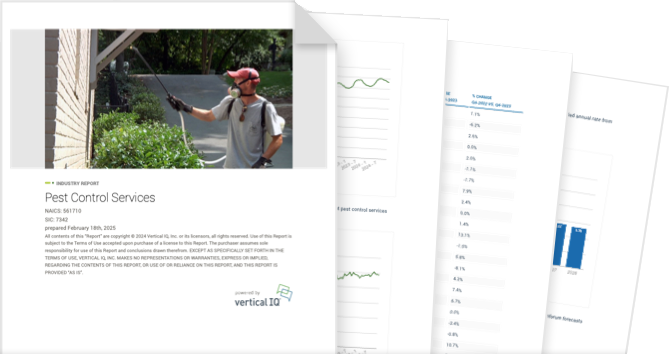Farm and Garden Machinery Wholesalers NAICS 423820

Unlock access to the full platform with more than 900 industry reports and local economic insights.
Get access to this Industry Profile including 18+ chapters and more than 50 pages of industry research.
Industry Summary
The 4,500 farm and garden machinery wholesalers in the US distribute machinery, equipment, and related parts used in the agricultural, farm, lawn, and garden industries. Major product categories include farm tractors; lawn and garden machinery; harvesting machinery; new land preparation, planting, and cultivating machinery; and irrigation machinery. Firms may sell new and used equipment or rent equipment. They also offer warranty, maintenance, and repair services.
Variability In Commodity Prices
Fluctuations in commodity prices -- driven by global market conditions -- affect farm income and farmers' ability to purchase new equipment.
Highly-Seasonal Demand
Demand for farm and garden machinery is highly seasonal and affected by weather and climate.
Recent Developments
Dec 6, 2025 - Tech Sells Tractors
- When purchasing a new tractor, farmers are giving preference to those that come with or are compatible with their preferred technology platform, Successful Farming reports. This increasing demand for tech-savvy farm machines could reshape manufacturers’ R&D priorities, product positioning, and dealership strategies. For farm equipment wholesalers, this means the “tech package” on a tractor can make a crucial difference: two otherwise identical tractors may sell for very different prices if one has the buyer’s preferred precision-ag system. As demand shifts, used tractors without modern tech will be harder to sell, while tractors (new or used) with compatible hardware and software will command premium pricing. Dealers who can install, service, and support these precision-ag systems, or offer third-party interface solutions, may have a competitive advantage.
- Artificial intelligence presents opportunities and risks for distributors of farm and garden equipment and their customers, Farm Equipment reports. A focus group of dealers convened by FE saw AI as a tool to streamline operations, from helping overworked service technicians troubleshoot equipment problems faster to improving inventory management and triaging customer calls. These applications could significantly reduce downtime and enhance customer service in wholesale distribution. However, FE warns of risks tied to open-source AI, in particular the potential for sensitive dealership and customer data to be exposed or misused. Moreover, dealers asked about their use of AI emphasized the importance of maintaining the human touch in customer relationships, a cornerstone of a relationship business like farm and garden equipment distribution. Wholesalers must adopt policies that balance innovation with privacy protections and ensure AI complements, not replaces, the personal trust that drives long-term customer loyalty.
- Off-season equipment maintenance of farm equipment like tractors and combines drives demand for farm machinery services and parts, creating key revenue opportunities for farm equipment wholesalers, Farm Progress reported in November. Dealers like Messick’s Farm Equipment incentivize farmers with off-season discounts, encouraging early repairs and tune-ups. A proactive approach increases sales of wear-and-tear components such as cutter knives, bearings, and filters. Wholesalers also gain from the growing complexity of modern machinery, which requires specialized parts and software updates. Strong dealer-farmer relationships highlight the importance of reliable parts availability and responsive service. Overall, off-season care not only ensures equipment readiness for both farm and landscaping equipment but also sustains a steady revenue stream for wholesalers during the slower winter months.
- The producer price index for machinery and supply wholesalers, a measure of input costs, rose 2.9% in August compared to a year ago after falling 1.3% in the previous August-versus-August annual comparison, according to the latest US Bureau of Labor Statistics data. Employment by farm and garden machinery and equipment merchant wholesalers shrank 5.4% year over year in July, while the average industry wage rose 7.9% over the same period to a new high of $32.44 per hour, BLS data show. Farm and garden machinery wholesalers are trimming payrolls amid rising labor and other input costs to protect margins. Sales for machinery and equipment wholesalers rose 3.7% in July compared to a year ago, according to the latest Census Bureau data.
Industry Revenue
Farm and Garden Machinery Wholesalers

Industry Structure
Industry size & Structure
The average farm and garden machinery wholesaler operates from a single location, employs about 26 workers, and generates $32.3 million in annual revenue.
- The farm and garden machinery wholesaling industry comprises about 4,500 firms, employs about 116,700 workers, and generates $144.3 billion annually.
- The industry is concentrated at the top and fragmented at the bottom; the top 50 companies account for 55% of industry revenue.
- Wholesalers include independent dealers for major machinery manufacturers, such as John Deere and Case New Holland Industrial. A dealership group operates multiple retail locations.
- The largest farm dealership groups include Titan Machinery (Case, New Holland), RDO John Deere, Rocky Mountain Equipment (Case), and James River Equipment (John Deere).
- According to the Association of Equipment Manufacturers, 2WD sub-40 horsepower tractors represented 69% of total farm tractor sales in May 2025, followed by 2WD 40-100 hp tractors (21%), and 2WD 100+ hp (8.5%). 4WD farm tractors represented about 1% of sales. Overall, there are 3.4 million tractors in operation in the US, with about 90% of farms reporting owning at least one tractor, according to the USDA.
Industry Forecast
Industry Forecast
Farm and Garden Machinery Wholesalers Industry Growth

Vertical IQ Industry Report
For anyone actively digging deeper into a specific industry.
50+ pages of timely industry insights
18+ chapters
PDF delivered to your inbox
